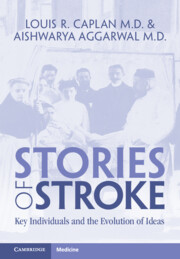Book contents
- Stories of Stroke
- Stories of Stroke
- Copyright page
- Contents
- Contributors
- Why This Book Needed to Be Written
- Preface
- Part I Early Recognition
- Part II Basic Knowledge, Sixteenth to Early Twentieth Centuries
- Part III Modern Era, Mid-Twentieth Century to the Present
- Types of Stroke
- Some Key Physicians
- Imaging
- Chapter Thirty One Cerebral Angiography
- Chapter Thirty Two Computed Tomography
- Chapter Thirty Three Magnetic Resonance Imaging
- Chapter Thirty Four Cerebrovascular Ultrasound
- Chapter Thirty Five Cerebral Blood Flow, Radionuclides, and Positron Emission Tomography
- Chapter Thirty Six Cardiac Imaging and Function
- Chapter Thirty Seven Stroke-Related Terms
- Chapter Thirty Eight Epidemiology and Risk Factors
- Chapter Thirty Nine Data Banks and Registries
- Chapter Forty Pediatric Stroke
- Care
- Treatment
- Part IV Stroke Literature, Organizations, and Patients
- Index
- References
Chapter Thirty Six - Cardiac Imaging and Function
from Imaging
Published online by Cambridge University Press: 13 December 2022
- Stories of Stroke
- Stories of Stroke
- Copyright page
- Contents
- Contributors
- Why This Book Needed to Be Written
- Preface
- Part I Early Recognition
- Part II Basic Knowledge, Sixteenth to Early Twentieth Centuries
- Part III Modern Era, Mid-Twentieth Century to the Present
- Types of Stroke
- Some Key Physicians
- Imaging
- Chapter Thirty One Cerebral Angiography
- Chapter Thirty Two Computed Tomography
- Chapter Thirty Three Magnetic Resonance Imaging
- Chapter Thirty Four Cerebrovascular Ultrasound
- Chapter Thirty Five Cerebral Blood Flow, Radionuclides, and Positron Emission Tomography
- Chapter Thirty Six Cardiac Imaging and Function
- Chapter Thirty Seven Stroke-Related Terms
- Chapter Thirty Eight Epidemiology and Risk Factors
- Chapter Thirty Nine Data Banks and Registries
- Chapter Forty Pediatric Stroke
- Care
- Treatment
- Part IV Stroke Literature, Organizations, and Patients
- Index
- References
Summary
The heart is a major source of brain embolism. Many stroke patients have coexistent coronary and valvular heart disease. Strokes can also cause secondary cardiac pathologies. Evaluation of the heart is an integral part of the care of stroke patients.
- Type
- Chapter
- Information
- Stories of StrokeKey Individuals and the Evolution of Ideas, pp. 352 - 357Publisher: Cambridge University PressPrint publication year: 2022

